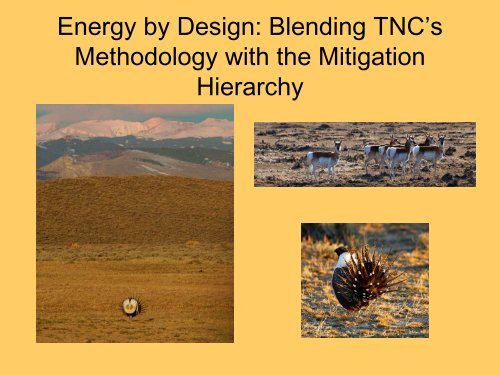Energy by Design: Blending TNC's Methodology with the Mitigation ...
Energy by Design: Blending TNC's Methodology with the Mitigation ...
Energy by Design: Blending TNC's Methodology with the Mitigation ...
Create successful ePaper yourself
Turn your PDF publications into a flip-book with our unique Google optimized e-Paper software.
<strong>Energy</strong> <strong>by</strong> <strong>Design</strong>: <strong>Blending</strong> TNC’s<br />
<strong>Methodology</strong> <strong>with</strong> <strong>the</strong> <strong>Mitigation</strong><br />
Hierarchy
TNC SCIENCE<br />
Ecoregional Planning
THE MITIGATION HIERACHY<br />
Avoid Minimize/Restore Offset<br />
+<br />
Positive contributions<br />
to biodiversity<br />
Biodiversity<br />
breakeven point<br />
(Zero impact)<br />
-<br />
Residual<br />
impacts<br />
Avoided<br />
impacts<br />
Residual<br />
impacts<br />
Minimize/<br />
Restore<br />
Avoided<br />
impacts<br />
Impact<br />
offset<br />
Minimize/<br />
Restore<br />
Avoided<br />
impacts<br />
No net loss for biodiversity<br />
Size of offset<br />
Net positive output<br />
for biodiversity<br />
Anticipated<br />
impacts<br />
TIME<br />
Modified from BBOP Bainbridge 2007 Rio Tinto
<strong>Energy</strong> <strong>by</strong> <strong>Design</strong><br />
a. Set <strong>the</strong><br />
Regional Context<br />
1. Set Priorities<br />
b. Develop<br />
Site-Level Goals<br />
2. <strong>Design</strong><br />
Strategies<br />
3-4. Take Action &<br />
Monitor Results<br />
Where are <strong>the</strong> biodiversity values in <strong>the</strong><br />
site<br />
Where are <strong>the</strong>se values throughout <strong>the</strong><br />
region<br />
What are <strong>the</strong> regional goals for <strong>the</strong>se<br />
values and to what extent are <strong>the</strong>y<br />
being achieved<br />
How much do <strong>the</strong> values in <strong>the</strong> site<br />
contribute to regional goals, and which<br />
values in <strong>the</strong> site are of highest<br />
priority<br />
Sample region (e.g., ecoregion,<br />
basin, county)<br />
COMPARE<br />
Sample<br />
Site (e.g.<br />
well field)
<strong>Energy</strong> <strong>by</strong> <strong>Design</strong><br />
a. Set <strong>the</strong><br />
Regional Context<br />
1. Set Priorities<br />
b. Develop<br />
Site-Level Goals<br />
2. <strong>Design</strong><br />
Strategies<br />
3-4. Take Action &<br />
Monitor Results<br />
For which areas is it most important to<br />
avoid impacts<br />
How can impacts best be minimized<br />
How can impacts best be rectified<br />
through restoration or reclamation<br />
For which areas is it most important<br />
that impacts be compensated through<br />
off-site mitigation and where are <strong>the</strong><br />
best opportunities located
Oil and Gas Impacts<br />
Current activity only represents 10-15%<br />
expected over <strong>the</strong> next 30 years.
Avoid<br />
Minimize/Restore Offset
Avoid Minimize/Restore Offset
Avoid Minimize/Restore Offset
Offsite <strong>Mitigation</strong> Questions<br />
1. How do you identify suitable offset sites<br />
2. How do you ensure offsite mitigation,<br />
compensates for onsite impacts<br />
3. How do you confirm offsets are ecologically<br />
equivalent<br />
4. Once offset sites are located how do you identify<br />
appropriate mitigation actions<br />
5. How do you ensure offsite mitigation conforms to<br />
<strong>the</strong> mitigation hierarchy
Jonah Infill Project: Current Wells ~500<br />
: Permitted Wells: 3100
A window of opportunity…<br />
- Off-site mitigation has been agreed to <strong>by</strong> <strong>the</strong> BLM,<br />
State of Wyoming and operators (Encana, BP) on<br />
<strong>the</strong> Jonah Field<br />
- No standard criteria or methodology has been<br />
identified to inform project selection<br />
- BP, a long standing partner <strong>with</strong> TNC and cosigner<br />
of <strong>the</strong> <strong>Energy</strong> and Biodiversity Initiative<br />
(EBI), has invited TNC to design a methodology<br />
- TNC has both methodology and technical capacity<br />
for large landscape analysis of biodiversity. This<br />
is one of <strong>the</strong> key ways for TNC to engage
Jonah <strong>Mitigation</strong> Goals<br />
Target Name Goal (Ha) Goal (Acres) Goal (Number) Minimum Viable Size<br />
Burrowing owl 13,690 33,828<br />
220 ha<br />
Cedar Rim thistle 3,433 8,483 n/a<br />
Mountain plover 1,390 3,435 1000 ha<br />
Pronghorn migration 7,738 19,121 n/a<br />
Pygmy rabbit 20,804 51,407 1100 ha<br />
Sage grouse (occupied leks)<br />
Sage grouse (winter/nesting/early broodrearing<br />
habitat) 20,955 51,780 700 ha<br />
6<br />
n/a<br />
Sage sparrow 8,813 21,777 100 ha<br />
White-tailed prairie dog 1,705 4,213 2024 ha<br />
Wyoming big sagebrush 22,573 55,778 6880 ha
Predictive Species Modeling<br />
Example: Sage Grouse<br />
Elevation<br />
Sage Grouse Winter/Breeding/<br />
Early Brood Rearing Habitat<br />
Data: Wyoming Wildlife Consultants, LLC<br />
TNC Predictive Habitat Model<br />
Goal: 20,955 ha<br />
Min. Viable Size: 700 ha
age Grouse Winter Pronghorn Migration RoutesPrairie Dog Complexes<br />
Sage Grouse Leks<br />
Sage Sparrow Wyoming Big Sagebrush Mountain Plover Cedar Rim Thistle<br />
Pygmy Rabbit<br />
Burrowing Owl
Dominant Land Ownership<br />
Fire Condition Class<br />
Invasive Weeds<br />
Barriers to migration<br />
Residential Development

















